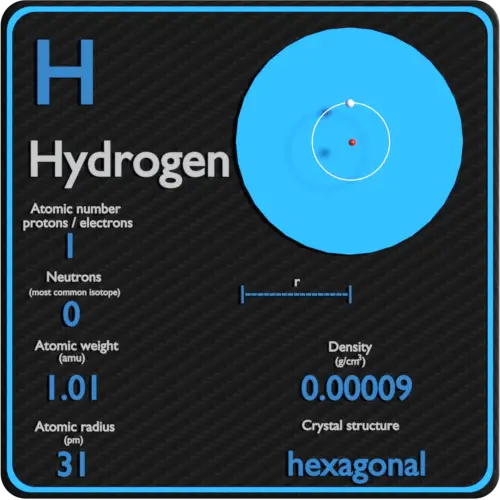

The third isotope, tritium, was discovered in 1934.Įstimated Crustal Abundance: 1.40×10 3 milligrams per kilogramĮstimated Oceanic Abundance: 1. The second, a stable isotope called deuterium, was discovered in 1932. The simplest isotope, called protium, is just ordinary hydrogen. Some of the common ones are: water (H 2O), ammonia (NH 3), methane (CH 4), table sugar (C 12H 22O 11), hydrogen peroxide (H 2O 2) and hydrochloric acid (HCl). Hydrogen combines with other elements to form numerous compounds. In normal conditions it’s a colourless, odourless and insipid gas, formed by diatomic molecules, H 2. Liquid hydrogen is used in the study of superconductors and, when combined with liquid oxygen, makes an excellent rocket fuel. Hydrogen is also added to fats and oils, such as peanut oil, through a process called hydrogenation. Large amounts of hydrogen are combined with nitrogen from the air to produce ammonia (NH 3) through a process called the Haber process. It is the most basic among all the periodic table elements in the. Hydrogen is a commercially important element. Hydrogen is the first member of the periodic table with the symbol H and atomic number 1. The sun's supply of hydrogen is expected to last another 5 billion years. The same process, known as fusion, is being studied as a possible power source for use on earth. Hydrogen is the raw fuel that most stars 'burn' to produce energy. It is estimated that 90% of the visible universe is composed of hydrogen. Hydrogen was first recognized as a distinct element by Henry Cavendish in 1766.Ĭomposed of a single proton and a single electron, hydrogen is the simplest and most abundant element in the universe. Written records indicate that Robert Boyle produced hydrogen gas as early as 1671 while experimenting with iron and acids. Hydrogen was discovered by Robert Boyle in 1671 from his work reacting acids and metals together but it was not until 1766 that the scientist Henry Cavendish isolated it as an element.Scientists had been producing hydrogen for years before it was recognized as an element. Hydrogen exists as a diatomic molecule, where two Hydrogen atoms are covalently bonded together. It has a melting point of -259°c and a boiling point of -252°c. As it is a non metal if it is located in Group 1 it can be misleading. Hydrogen is located usually in Group 1 but can also be located in the centre of the periodic table. It was used in the German airship, the Hindenburg which tragically exploded due to the flammable nature of Hydrogen in 1937. It has a large use in powering rockets in the NASA space program due to its high combustibility. It is possible to combust Hydrogen with Oxygen to create water as a by product and generate electricity in a cell. Hydrogen is being explored as use for a fuel. Find physical data, electron configuration, chemical properties, aggregation states. It is used in industrial processes such as the Haber process and the hydrogenation of fats. Get the facts about element Hydrogen (H) 1 from the periodic table. Being constructed of 1 proton and 1 electron it has no neutrons. Hydrogen is the most abundant element in the universe. It is a noble gas, non-metal and is the most abundant element in the universe. Hydrogen (H) is a tasteless, colorless, odorless gas and has the atomic number 1.


 0 kommentar(er)
0 kommentar(er)
